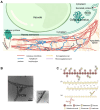Advances in Cell Wall Dynamics and Gene Expression in Postharvest Fruit Softening
- PMID: 41011983
- PMCID: PMC12473168
- DOI: 10.3390/plants14182831
Advances in Cell Wall Dynamics and Gene Expression in Postharvest Fruit Softening
Abstract
Postharvest fruit softening is a critical determinant of fruit shelf life, significantly influencing mechanical damage susceptibility, pathogen invasion, and consumer preference. Collectively, these factors lead to substantial losses in the fruit industry. The structural modifications of cell wall and cuticle during ripening primarily govern fruit softening. The objective of this review is to synthesize recent advances and provide a comprehensive analysis of the molecular mechanisms underlying this process. In this review, we provide a comprehensive analysis of cell wall composition and softening-associated cell wall remodeling proteins. We examine recent advances in manipulating single or multiple genes encoding cell wall-modifying proteins that influence fruit softening, and identify key transcription factors regulating the expression of these gene networks. This review synthesizes current understanding of the molecular mechanisms governing fruit ripening, providing a foundation for future research in postharvest biology.
Keywords: fruit quality; polysaccharide metabolism; shelf life; transcriptional regulation; water loss.
Conflict of interest statement
The authors declare no conflicts of interest.
Figures



References
-
- Li T., Liu L., Yang G., Cai Y., Wang Y., Sun B., Sun L., Liu W., Wang A. Ethylene-Activated E3 Ubiquitin Ligase MdEAEL1 Promotes Apple Fruit Softening by Facilitating the Dissociation of Transcriptional Repressor Complexes. Adv. Sci. 2025;12:e2417393. doi: 10.1002/advs.202417393. - DOI - PMC - PubMed
Publication types
Grants and funding
- 21326310D/Hebei Modern Seed Industry Science and Technology Innovation Project
- 2022KJCXZX-CGS-5/Hebei Academy of Agricultural and Forestry Sciences Science and Technology Innovation Project
- 2023KJCXZX-CGS-10/Hebei Academy of Agricultural and Forestry Sciences Science and Technology Innovation Project
- CARS-30- ZY-27/China Agricultural Research System
- C24R0603/PhD Start-up Fund of Hebei Academy of Agriculture and Forestry Sciences
LinkOut - more resources
Full Text Sources

